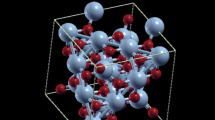Abstract
Transition metal dichalcogenide materials MX2 (M = Mo;W;X = S; Se) are being thoroughly studied due to their novel two-dimensional structure, that is associated with exceptional optical and transport properties. From a computational point of view, Density Functional Theory simulations perform very well in these systems and are an indispensable tool to predict and complement experimental results. However, due to the time and length scales where even the most efficient DFT implementations can reach today, this methodology suffers of stringent limitations to deal with finite temperature simulations or electron-lattice coupling when studying excitation states: the unit cells required to study, for instance, systems with thermal fluctuations or large polarons would require a large computational power. Multi-scale techniques, like the recently proposed Second Principles Density Functional Theory, can go beyond these limitations but require the construction of tight-binding models for the systems under investigation. In this work, we compare two such methods to construct the bands of WSe2. In particular, we compare the result of (i) Wannier-based model construction with (ii) the band fitting method of Liu et al.,[1] where the top of the valence band and the bottom of the conduction band are modeled by three bands symmetrized to have mainly Tungsten dz2, dxy and dx2-y2character. Our results emphasize the differences between these two approaches and how band fitting model construction leads to an overestimation of the localization of the real-space basis in a tight-binding representation.
Similar content being viewed by others
References
Gui-Bin Liu, Wen-Yu Shan, Yugui Yao, Yao Wang and Di Xiao, Phys. Rev. B 88, 085433 (2013).
Jason S. Ross, Sanfeng Wu, Hongyi Yu, Nirmal J. Ghimire, Aaron M. Jones, Grant Aivazian, Jiaqiang Yan, David G. Mandrus, Di Xiao, Wang Yao and Xiaodong Xu, Nat Commun 4, 1474 (2013).
Sefaattin Tongay, Jian Zhou Can Ataca, Kelvin Lo, Tyler S. Matthews, Jingbo Li, Je_rey C. Grossman, Junqiao Wu, Nano Lett., 12, 11, 5576–5580 (2012).
Hualing Zeng, Gui-Bin Liu, Junfeng Dai, Yajun Yan, Bairen Zhu, Ruicong He, Xie Lu, Shijie Xu, Xianhui Chen, Yao Wang and Xiaodong Cui, Scienti_c Reports 3, 1608 (2010).
Ming-Wei Lin, Lezhang Liu, Qing Lan, Xuebin Tan, Kulwinder S Dhindsa, Peng Zeng, Vaman M Naik, Mark MingCheng Cheng and Zhixian Zhou, J. Phys. D: Appl. Phys. 45345102 (2012).
Wenzhong Bao, Xinghan Cai, Dohun Kim, Karthik Sridhara & Michael S. Fuhrer, Appl. Phys. Lett. 102, 042104(2013).
Stefano Larentis, Babak Fallahazad & Emanuel Tutuc,Appl. Phys. Lett. 101, 223104 (2012).
Xin Luo, Yanyuan Zhao, Jun Zhang, Minglin Toh, Christian Kloc, Qihua Xiong & Su Ying Quek, Phys. Rev. B,88, 195313 (2013).
Rafael de Alencar Rocha, Wiliam Ferreira da Cunhaand Luiz Antonio Ribeiro Jr., J. Mol. Modeling 25, 290 (2019).
Feliciano Giustino, Rev. Mod. Phys. 89, 015003 (2017).
J. C. Slater and G. F. Koster, Phys. Rev. 94, 1498 (1954).
Ian David Brown, Chem. 109, 12, 6858–6919 (2009).
T. J. Giese and D. M. York, TheorChem Acc. 131, 1145(2012).
J. Spaek, Phys. Rev. B 37, 533 (1988).
W. Zhong, David Vanderbilt, and K. M. Rabe, Phys. Rev.B 52, 6301 (1995).
Pablo Garcia-Fernandez, Jacek C. Wojde, Iiguez Jorge, and Javier Junquera, Phys. Rev. B 93, 195137 (2016).
Jacek C Wojde, Patrick Hermet, Mathias P Ljungberg, Philippe Ghosez and Jorge iguez, J. Phys.: Condens. Matter 25 305401 (2013).
A. A. Mosto_, J. R. Yates, Y.-S. Lee, I. Souza, D. Vanderbilt, and N. Marzari, Comput. Phys. Commun. 178, 685(2008).
Jose M. Soler, Emilio Artacho, Julian D. Gale, Alberto Garcia, Javier Junquera, Pablo Ordejon, Daniel SanchezPortal, J. Phys.: Condens. Matter 14 2745 (2002).
Nicola Marzari, Arash A. Mosto, Jonathan R. Yates, Ivo Souza, and David Vanderbilt, Rev. Mod. Phys. 84, 1419 (2012).
John P. Perdew, Kieron Burke, and Matthias Ernzerhof, Phys. Rev. Lett. 78, 1396 (1997).
Leonard Kleinman and D. M. Bylander, Phys. Rev. Lett. 48, 1425 (1982).
N. Troullier and Jos Lus Martins, Phys. Rev. B 43, 1993 (1991).
Javier Junquera, Oscar Paz, Daniel Sanchez-Portal, and Emilio Artacho, Phys. Rev. B 64, 235111 (2001).
Hendrik J. Monkhorst and James D. Pack, Phys. Rev. B 13, 5188 (1976).
Juana Moreno and Jos_e M. Soler, Phys. Rev. B 45, 13891 (1992).
SCALE-UP webpage https://www.secondprinciples.unican.es/. (Accessed 4 February 2020)
Swastibrata Bhattacharyya and Abhishek K. Singh, Phys. Rev. B 86, 075454 (2012).
Author information
Authors and Affiliations
Rights and permissions
About this article
Cite this article
Sifuna, J., García-Fernández, P., Manyali, G.S. et al. Comparison of band -fitting and Wannier-based model construction for WSe2. MRS Advances 5, 2281–2290 (2020). https://doi.org/10.1557/adv.2020.111
Published:
Issue Date:
DOI: https://doi.org/10.1557/adv.2020.111




